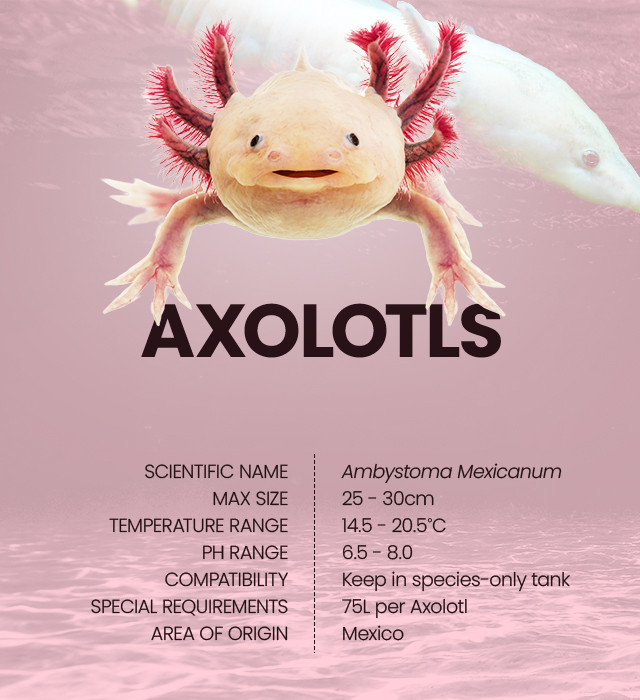




Axolotls (Ambystoma mexicanum) are a species of salamander that never go through metamorphosis and live their entire lives seemingly as babies. Axolotls are amphibians that live underwater, unlike other amphibians that only start their life in the water as larvae. Axolotls never technically grow up, retaining their youthful appearance, yet can breed when they reach adulthood. Although there is only one species of axolotl, they come in a wide variety of colour morphs.
Axolotls are endemic to Lake Xochimilco in Mexico City. They are critically endangered in the wild, with an estimated 50-1000 remaining in the lake. The pink leucistic axolotl is commonly kept in aquariums, but is very rare in the wild, as most wild axolotls are deep brown or copper.
Axolotls are a carnivorous amphibian and benefit from a diet of bloodworm, dendrobaena worms or brineshrimp. You can find these foods live, frozen, freeze-dried or in pellet form. To provide a healthy diet to your axolotl, offer a mix of live or frozen food, as well as freeze-dried or pellet food. It is recommended to feed your axolotl with sinking foods, as they spend most of their time at the base of their tank.
Frozen food is very straightforward to feed with, although a little messy at times. You can either defrost the block of food beforehand or add it straight into the aquarium. Submerging a food dish can prevent waste from spreading into your substrate.
It is advised to provide 75 litres of water per axolotl. Axolotls can grow as large as 30cm which means they need a large aquarium to allow plenty of room for them to walk around. As juveniles, axolotls can live in a smaller aquarium of around 60cm, but they quickly outgrow these tanks. A tank that measures 90cm or more allows room for your axolotl to manoeuvre when they are fully grown. Axolotl aquariums do not need to be very tall, as length and depth are more important when it comes to providing space for your pet.
It is always a good idea to prepare you aquarium before your axolotl arrives by testing the parameters of your water and the temperature. Having suitable water conditions in advance allows a higher rate of survival for your new axolotl. Turn off all aquarium lighting before acclimating your axolotl. As soon as your new axolotl arrives, float the bag in your aquarium for 30 minutes. After this, undo the bag and gradually add water from your tank for a further 20 minutes. This process allows your axolotl to get used to your aquarium water.
We recommend transferring your axolotl to the aquarium using a fine mesh fish net. By doing this, you won’t add any dirty water from the bag to your aquarium. Your new axolotl will likely be stressed after their journey, so allow them some time to settle into their new environment before you turn on the aquarium lights and offer them food. After a few days, your axolotl will become more active and vibrant in colour.
All our aquatic animals are dispatched from our livestock distributers and delivered directly to your door. To avoid animals being held up in transit over the weekend, our distributors deliver livestock packages Tuesday through Friday. Our couriers aim to make livestock deliveries before 1pm on the day of delivery to minimalise the time your axolotl spends travelling.
After you place the order for your axolotl, you will receive a series of emails with all the information you will need to track your pet from the distributers to your door. On the day of delivery, you will receive an insulated polystyrene box containing a plastic bag. Your axolotl will be inside this securely fastened bag that is filled with oxygen and water.
Any non-livestock items you have purchased alongside your axolotl will be sent separately via standard or express delivery. You may receive your non-livestock items before or after your livestock package.
It is important to note that, as an online fish shop, all our livestock images are for illustration purposes only. This means that axolotls and any other aquatic animals photographed for our listings are not an exact representation of what you will receive. Due to variations in the colour morphs, your axolotl may look different to the one in the photograph.